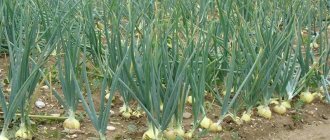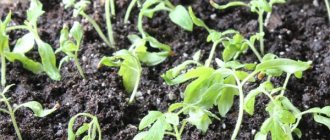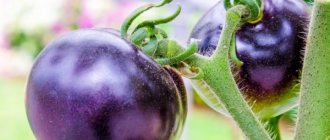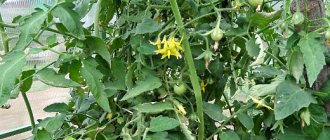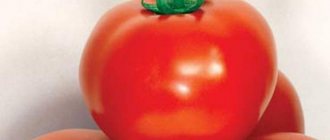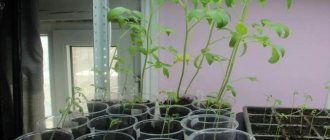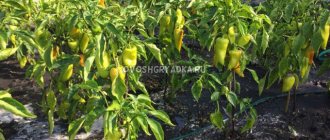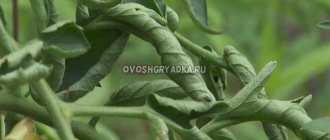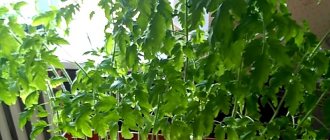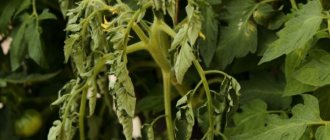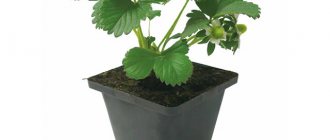One of the first problems we encounter when growing tomatoes is that the lower leaves of the seedlings begin to turn yellow. Of course, this is a worrying sign. In the worst case, young plants may die, and if they survive, they are unlikely to be productive.
Remember from botany lessons: photosynthesis occurs in the leaves, without it the nutrition and development of the entire plant is disrupted. Weak and sickly tomatoes, after planting in the garden, will spend more time recovering than healthy ones; later they will begin to set fruit, which means we will harvest fewer tomatoes. Therefore, at the first signs of yellowing, it is necessary to urgently identify and eliminate the causes.
Tomato leaves of seedlings turn yellow: reasons. Lack of light
Tomatoes love light very much. Its deficiency leads to yellowing of the entire plant, and the lower leaves become bright yellow. At the same time, the tomatoes themselves will stretch in search of light and look weak.
How to avoid. Place the seedlings on the brightest window, preferably on the south side. Illuminate the seedlings until they are a month and a half old; to do this, buy a fluorescent lamp and leave it on: on sunny days for 12 hours, on cloudy days for 16 hours. To increase the intensity of lighting, behind the seedlings you can place something that will reflect the light, for example, foil or a mirror.
How to fix. Increase the lighting with a fluorescent lamp to 20 hours. Light up in the evening and at night. You can also install an ordinary table lamp nearby.
Proper care of seedlings
When growing seedlings, the decisive factors are light and temperature conditions, as well as proper watering:
Lighting is especially important for growth in the first days after emergence.
At this time, the daylight hours should be 16 hours long; when the seedlings grow and become stronger, additional lighting can be reduced so that the plants get a total of 12 hours a day, taking into account natural light.
The temperature in the room with seedlings at the germination stage should be in the range of 22-25°C. After the sprouts appear, the temperature is reduced to 16-17°C; in such conditions, the seedlings should be kept for 1-2 weeks so that the growth of the above-ground part slows down
After this, the tomatoes are again raised to their previous temperature.
It is better to water very small seedlings using a syringe; when the bushes grow a little, the dose of water needs to be increased, but water the tomatoes no more than once a week, preferably through a tray. If moisture gets on the tender stems, the plants may get blackleg.
Fertilizing with complex fertilizers is carried out, focusing on the appearance of the seedlings. If the seeds were sown in soil with a balanced composition, then the first time you will need to apply fertilizer a week after picking. Healthy seedlings have thick stems, compact sizes and bright green leaves.
Tomato leaves and seedlings turn yellow: exposure to sunlight
In spring, on sunny days, the sun can burn seedlings on a windowsill or in a greenhouse. Whitish spots appear along the edge or in the center of the leaf and dry out. As a result, the sheet becomes thin, paper-like. The plant itself acquires a light green tint, and after a while yellow.
How to avoid. Shade plants both on the window and in the greenhouse, as well as within a week after planting.
How to fix. If the burns are severe, then nothing can be done; the plant will dry out. If only a few leaves are damaged, cut them off. Remove the plant itself from the window. Place it where direct sunlight will not fall on it. When the tomatoes turn green again, you can bring them back, but be sure to shade them.
How to fix
It's easier to prevent than to treat. Prevention measures:
- disinfect seeds before planting;
- take into account the characteristics of the variety;
- use spacious pots;
- control the plant (when it has turned yellow and is ready to shed its leaves);
- Damaged parts of the bush are disposed of (leaves are torn off);
- remove foliage with hands or scissors without damaging the stem.
If the plant is not in critical condition, comfortable conditions are created for it. If the leaves of tomato seedlings turn yellow, what to do first is to start treatment.
Provide normal amount of light
With a lack of light, the seedlings become thin and stretched, turn pale, and the leaves in the middle suffer. Plants should be placed in the sun or phytolamps placed nearby. The bushes are planted deeper and further away from each other so that they receive equal amounts of sun. If you leave them in the shade, the tops will remain yellow and the crop will be lost.
Excess sun is also harmful. To avoid burns, the bushes must be sprayed with water.
Checking soil moisture
To regulate moisture, you can use a drip system. This is not difficult to do. A bottle of water is buried next to the plant. Excess moisture is removed by digging small ditches to remove excess water. With abundant watering, the fruits become watery. When there is groundwater on the site, drainage or high beds are organized.
Soil moisture
Before watering, loosen the soil, moisten only the soil that has dried out from the previous time. Humidity levels up to 65% are optimal.
Cleaning from rot
Rotting occurs at high humidity. Rotten tomato bushes cannot be saved. Sick plants are removed so that they do not infect healthy ones. After removal, the soil is disinfected.
Top dressing
The following fertilizers are used when there is a deficiency of substances:
- Nitrogen. Add a spoonful of urea to 10 liters of water and feed the tomatoes with the solution.
- Phosphorus. Superphosphate is poured into 1 liter of hot water and left for 8 hours. Pour into 10 liters of water and pour half a liter under each bush.
- Potassium. Add 1 spoon of saltpeter to 10 liters of water and water the bushes. Or 1 teaspoon of potassium chloride is dissolved in 1 liter of water.
- Magnesium. 1 teaspoon of magnesium nitrate is diluted in 10 liters of water.
- Molybdenum. Prepare a solution (2 g of ammonium molybdate per 10 liters of water).
- Calcium. Calcium nitrate (20 g) is diluted in 10 liters of water.
- Bor. The foliage is irrigated with a solution of boric acid.
- Sulfur. 1 gram of magnesium sulfate is diluted in 1 liter of water.
- Iron. Iron sulfate (1 g) is added to water (10 liters).
- Copper. 1 gram of copper sulfate is mixed with water (10 liters).
- Manganese. Make a solution for foliar fertilizer (add 5 g of manganese sulfate to 10 liters of water).
- Chlorine. The deficiency can be eliminated by spraying with water containing potassium chloride (1 teaspoon per 1 liter of water).
Feeding tomato seedlings
To avoid deficiency, fertilizers with a complex of substances are used during the flowering period.
Ventilation of the room
Benefits of ventilation:
- decrease in humidity;
- increase in nitrogen content.
It is necessary to monitor the process. Hypothermia is unacceptable.
Temperature control
Temperature affects the absorption of trace elements and minerals. Indoors and in the greenhouse, monitor distance and ventilation. A shelter is arranged over the street beds and fabric is stretched. In hot weather, the soil is moistened, but the leaves are not sprayed during the day due to the likelihood of burns.
Irrigation control
Watering mode:
- moderation;
- each subsequent watering after the soil dries;
- periodic loosening of the soil.
Water the plants at the base, not from above. Moisture should not get on the foliage.
Irrigation regime violations
Overmoistening, just like drought, leads to yellowing of seedlings. With heavy watering, the leaves fade, turn yellow, but do not dry out. If there is a lack of water, the leaves of the plant wilt, curl and dry out.
If there is an excess of water, as a rule, the symptoms appear in all seedlings; if there is a shortage, the symptoms may appear only in some plants.
How to avoid. Do not allow the soil to become waterlogged or dry out. You need to water the plants when the soil becomes dry.
How to fix. If there is a lack of water, water the tomatoes, but there is no need to immediately pour out a large amount of water. Water intermittently and little by little until the plants acquire their natural color. If the leaves on the plants have already curled and dried out, then it is better to tear them off; they will not recover.
If there is excess water, watering should be stopped immediately until the soil dries out. If the soil is very waterlogged, then plant the plants in another container, and add dry soil to the soil. If after 10 days the yellowness does not go away, then the plant died.
Diseases and pests
Poor quality soil is also a cause of infection by diseases and pests. The soil may contain fungal spores, as well as insect larvae and eggs. Most often, tomato seedlings suffer from blackleg, but signs of brown spotting and Fusarium wilt may also appear. In each case, the leaves become spotted or turn yellow entirely.
As for pests, the following can pass from the soil to the seedlings: greenhouse whiteflies, spider mites, and aphids. Parasites suck juices from plants. As a result, the leaves of tomato seedlings turn yellow, curl, and then fall off.
Dense planting
If you plant tomatoes too densely, they will compete with each other for space, light, water and nutrition. Signs of lack of space may appear as early as the 2-3 leaf stage. The plant stretches and becomes stunted. The lower leaves turn yellow and the upper leaves turn pale green.
How to avoid. Plant no more than 3-4 seeds in each pot.
How to fix. Seedlings need to be planted in separate containers. If you have two plants in pots one at a time, but they are close to each other on the windowsill. They will also compete for light. Since the leaves of neighboring plants shade each other. To correct the situation, simply place them more freely on the windowsill.
Causes of yellowing leaves in tomatoes
After germination, tomato seedlings first develop two cotyledon leaves. Then, as they grow, real leaves appear with a color and shape characteristic of a particular variety.
Yellowing and drying of cotyledon leaves is a common phenomenon, indicating that the plant has used up its initial supply of nutrients. Further nutrition occurs through new shoots, true leaves and the root system of tomatoes. Therefore, yellowing of formed shoots and leaves is a signal that the tomatoes have some problems.
Causes:
- insufficient lighting;
- temperature violations;
- lack or excess of moisture;
- nutritional deficiency;
- small volume of container in which tomatoes grow;
- damage to the root system (during a dive);
- the presence of fungi or other pathogens in the soil mixture.
Leaves also turn yellow when plants are planted closely. In this case, tomatoes can grow both in one seedling box and in separate pots. In the second case, the containers with seedlings are placed too tightly on the windowsill and the plants come into contact with each other.
Insufficient lighting
Tomatoes are a light-loving crop, so seedlings are grown on windows, closer to the light. The duration of daylight hours should be from 9 to 12 hours.
On a note! It is best to place seedlings on south-eastern or eastern windows.
In February and March, when there is still little sun, young plants often do not have enough light. This causes the leaves to turn yellow. Closer to May, another problem with lighting may arise: sunburn on tomatoes. This happens especially often with plants on southern windows.
Temperature violations
Tomatoes need warmth, and the temperature must be stable. Changes between day and night lead to leaf shedding and slower growth. Dry air from heating devices, drafts from vents and open doors have a negative effect on plants.
In addition to yellowness, a bluish or purple tint often appears on the leaves and twigs. This is an indicator that the seedlings are exposed to a strong difference in day and night temperatures.
Improper watering
A common cause of yellowing seedlings is excess soil moisture. The soil acquires a sour smell, plaque and whitish spots appear on the surface. In addition to yellowing, tomatoes may develop a dangerous infection - black leg. With the slightest delay in treatment, it is easy to lose all the tomato seedlings.
Prolonged droughts and lack of moisture are also unacceptable for seedlings. With such changes, tomatoes experience stress and slow down their development.
Nutritional deficiency
Tomato seedlings grow quickly in favorable conditions. Seedlings intensively increase green mass, drawing nitrogen from the soil. Balanced soil mixtures for young plants have enough nutrients, but if there is a lack of nitrogen, the leaves will turn yellow and die. The plant actively redistributes nutrition, delivering the necessary substances from old leaves to the cells of new leaves. At the same time, chlorosis develops on the lower leaf blades and they dry out.
The appearance of yellow spots, as well as curling of young foliage on tomatoes, indicates a deficiency of potassium in the soil. If yellowness appears on the leaves along the veins, then this is a signal of magnesium deficiency.
Close planting
Gardeners often sow tomatoes in common seedling boxes and containers. If the plants are picked in time into separate capacious containers, there will be no problems. But it happens that tomatoes remain in the boxes, intertwined with roots.
A large number of seedlings in one container is not only a possible nutritional deficiency, but also a lack of free space for plants and a lack of normal ventilation. In such conditions, tomatoes stretch out and their leaves turn yellow.
The problem also arises when picking plants into cups that are too small, from which the tomatoes quickly grow.
Unsuitable soil
Yellowing and falling of plant leaves is caused by poor-quality soil. Store-bought nutrient mixtures and home-prepared soil for planting seedlings require mandatory disinfection and treatment.
Tomatoes do not grow well in heavy soils with a lot of peat. Such soil is often covered with a salt crust and cakes, forming solid fragments inside the pots. The root system of plants does not receive enough oxygen, which disrupts the nutritional process of tomatoes and leaves turn yellow.
Diseases and pests
Inexperienced gardeners often forget that the cause of yellowing of seedlings at home can be crop diseases, as well as pests. Dangerous for tomatoes:
- blackleg;
- fusarium;
- various rots.
Infections appear under conditions of high humidity, high or, conversely, low temperatures, and dense plantings.
With a black leg, the stems at the bottom become thinner, and a constriction appears. The disease progresses quickly in conditions of high soil moisture, and “mows down” all the seedlings.
With fusarium, the lower leaves begin to turn yellow, then gradually brown spots appear on the top of the seedlings. The stem cut appears brown and the plants wither and die.
On a note! At the first symptoms of the disease, the affected plants are removed from the boxes and destroyed.
Small containers for planting
Tomatoes that are planted in small containers become cramped over time. The roots have little room to grow; they intertwine and wrap around the ground. As a result, the roots begin to perform their functions poorly, the plant does not receive additional nutrition and the lower leaves turn yellow. If measures are not taken, the entire plant will turn yellow.
How to avoid. Plant tomatoes in large containers. Before picking, the volume should be in the range of 50-70 ml, after 200-300 ml.
How to fix. Plant the plants in large containers. We cut off the roots that are wrapped around the earthen ball, since they do not serve any function. We trim the other roots a little. After transplantation, the plant should return green in 2-4 days. If before planting in the ground, the signs appear again, then they should already be planted in the ground, and if it is too early, then plant them, but do not cut the roots.
Tomato leaves and seedlings turn yellow: nitrogen deficiency
If, when feeding tomatoes, you use fertilizers that contain little or no nitrogen, the plant will suffer from a lack of it. Nitrogen deficiency causes seedlings to stop growing and become weak. The leaves become smaller and turn yellow. The stronger the lack of this element, the more yellow the plant turns.
How to avoid. Use soil containing nitrogen for planting. Include this element in fertilizing fertilizers.
How to fix. Urgently feed the plant with fertilizers containing nitrogen. You can use complex or houseplant fertilizers. But you shouldn’t get carried away, since excess nitrogen has just as bad an effect on plants as its deficiency. The seedlings will begin to grow quickly and will grow long before being planted in the ground.
Wrong soil
Tomatoes grow well in slightly acidic soils. If the soil in which you planted the tomatoes is alkaline, then they will not have enough iron. If the soil is acidic, then the tomatoes will lack almost all elements.
How to avoid. Choose the right soil. The soil pH should be between 5-6.
How to fix. You need to find out what kind of soil you have. For alkaline soil, water it with a weak solution of potassium permanganate. Add peat to the soil. Ammonium sulfate should not be used as it is difficult to calculate the correct dose for a small container.
To reduce acidity, add a solution of ash to the soil. Or other drugs intended to reduce acidity, purchased at the store.
Tomato leaves and seedlings turn yellow: incorrect picking
When transplanting, seedlings always wilt a little. But if the root system was damaged during picking, then yellow spots appear on the lower leaves. With minor damage, tomatoes recover within a few days. If the roots are severely damaged, the plant dies.
Also, immediately after picking, there is no need to place the tomatoes on the windowsill under the sun's rays. Because the roots have not yet had time to recover and cannot absorb water.
How to avoid. Carefully replant seedlings, preferably with a clod of earth. After transplantation, you can put it on the window after 2-3 days.
How to fix. In mild cases, water the plant with a root formation stimulator. In severe cases, the plant cannot be saved.
Why do the leaves dry out on tomato seedlings?
Most often, seedling leaves dry out due to too high a temperature in the room. If a box with plants is located, for example, near a working radiator, you need to move it to another place or fence it off from the heat source using wide plywood. Also, seedlings dry out due to insufficient humidity in the room; use a humidifier or simply place large containers of water next to the seedlings.
The cause of leaf drying may be salting of the substrate due to watering with hard water or excessive fertilizing. In this case, it is recommended to carefully remove the top layer of soil and add fresh soil.
The main signs of soil salinity are white or yellowish spots on the surface
If the leaves begin to dry out after picking, it means that the roots of the seedling have been damaged . To bring the plant back to life faster, you can spray it with a weak solution of complex mineral fertilizer.
Planting unhardened seedlings in the ground
Tomatoes may turn yellow when transplanted into soil. This occurs due to changing temperature conditions. All this time it grew at a temperature that was comfortable for them. And in a greenhouse, the temperature can change day and night. Therefore, the plant experiences stress.
How to avoid. A week before planting in the ground, begin to harden off the plants. To do this, take the seedlings outside during the day. First for half an hour, then for an hour, and so on gradually throughout the day. Bring it back at night.
How to fix. As a rule, the plant recovers on its own within a couple of days. Gets used to new conditions. But if this does not happen, you can treat it with growth stimulants.

